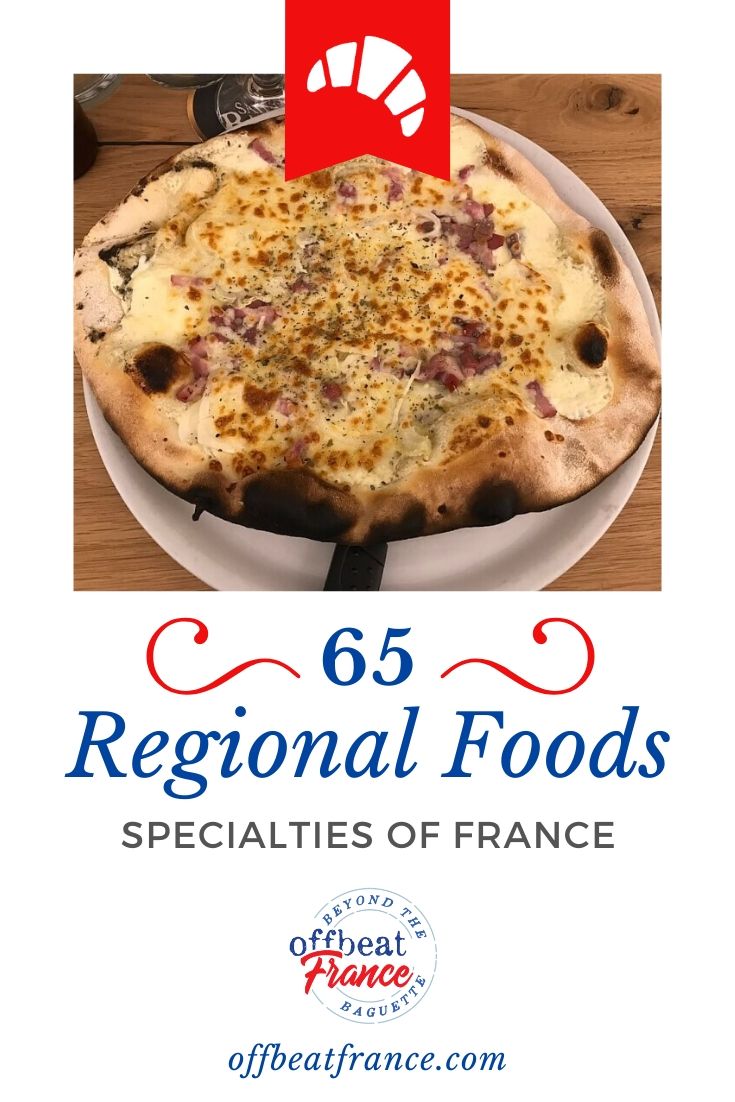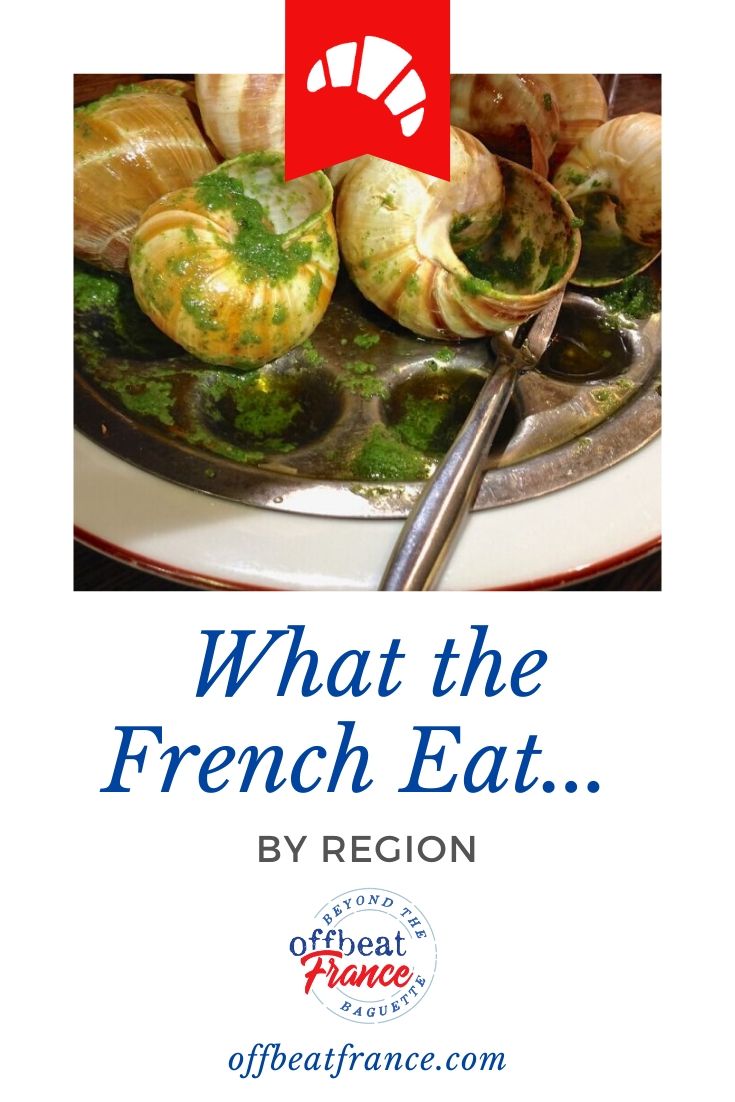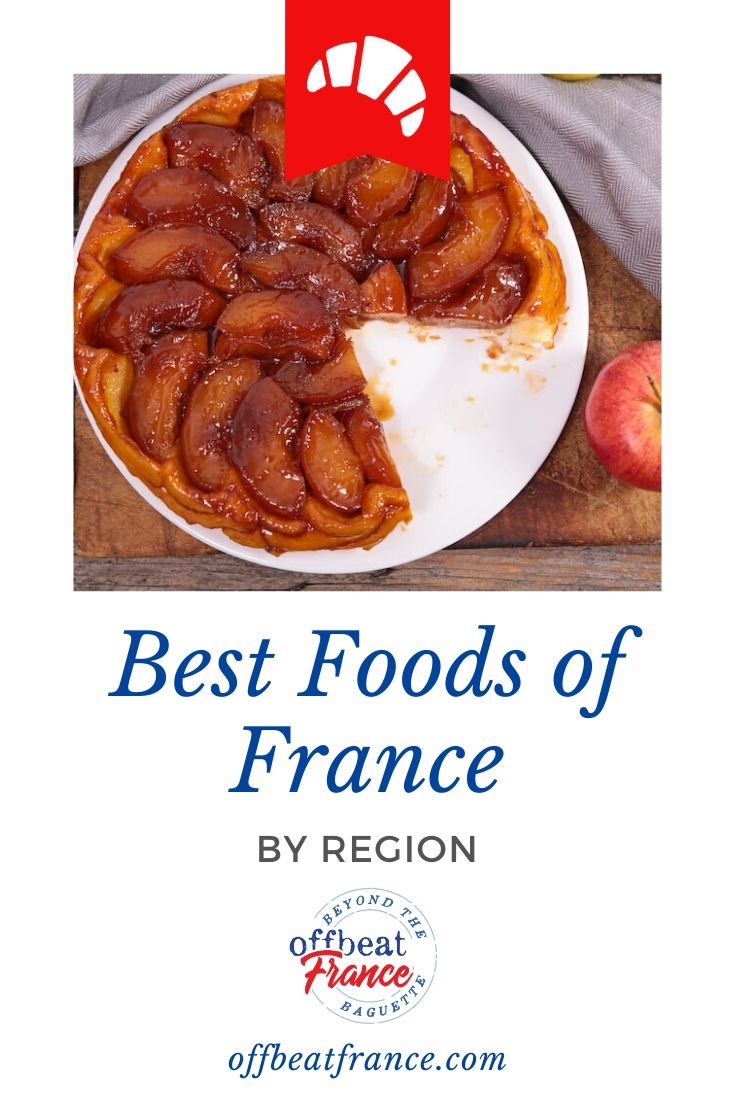Unsure about your French table manners? Click Here to download > > How to avoid these 10 food etiquette mistakes !
French Gastronomie: What is the Most Popular French Food?
Published 3 December 2020 by Leyla Alyanak
France is known for its culinary excellence, and here I detail some of the most popular French food specialties from each region, along with a bit of culinary history to put things into perspective.
France makes plenty of things – from modern technologies like aircraft production or bridge building to what is perhaps our most famous cultural export: the wine and the food which shape our character and our persistent desire for the unique and the excellent.
French cuisine history and heritage
France's culinary tradition is deemed so essential and unique that UNESCO has inscribed the French gastronomic meal on its list of Intangible Cultural Heritage. Yes – our entire food tradition, the French gastronomic meal, which consists of the following:
- The typical French dinner menu is made up of 3-4 courses
- Hors d'oeuvres or entrée − the starter, in other words
- Plat principal, or main course
- Fromage, or cheese course (may be served with a small salad)
- Dessert
- The meals are served with bread, and water or wine
- French drinks before, during or after the meal
During the medieval era, show was everything. Food appeared en confusion, with all dishes together: no starter or main course, just food. Everything was laid out on huge tables rather than served individually, and eating utensils hadn't become mainstream yet.
"The Medieval Kitchen is a delightful work in which historians Odile Redon, Françoise Sabban, and Silvano Serventi rescue from dark obscurity the glorious cuisine of the Middle Ages. Medieval gastronomy turns out to have been superb—a wonderful mélange of flavor, aroma, and color." (from Amazon)
Manners dictated diving in with your hands. Meat and sauces were popular, as was the notion that great food should also be seen, not just tasted.
For example, certain birds would be emptied, their meats cooked, and then stuffed back into the carcass, which would be sewn up, its feathers put back to their original place.
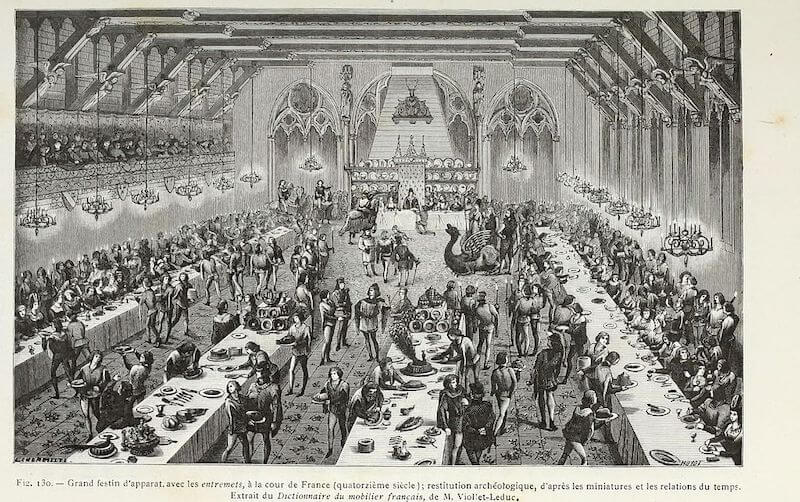 Banquet meal in 14th-century France
Banquet meal in 14th-century FranceBy the Renaissance, France looked to Italy for inspiration in many areas, from clothing to architecture and cuisine.
For this you can thank Catherine de Medici, the Florentine wife of Henry II, who arrived at court with her retinue of cooks. She may have introduced lasagna to France, although it's a little difficult to imagine Henry slurping up oodles of noodles. Still, she believed in the harmony of colors at the table and used fine porcelain and serving dishes.
Things changed under Louis XIV at Versailles, servants would bring and serve each course separately rather than en confusion, and you would be expected to know and use silverware.
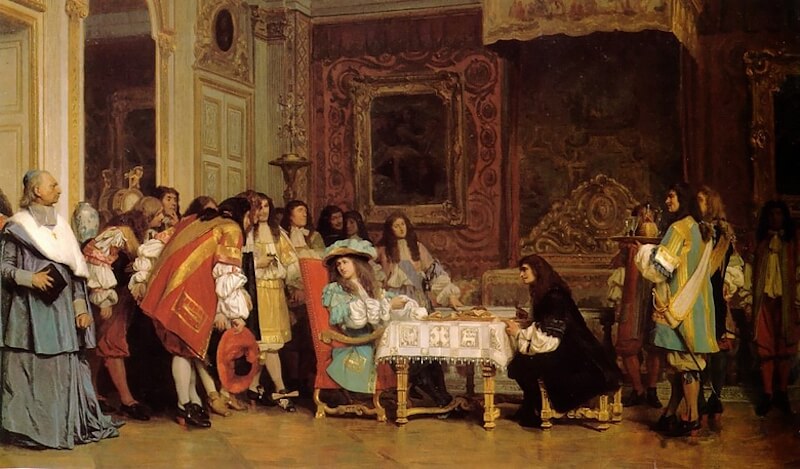 King Louis XIV invites the playwright Molière to share his supper (painting by Jean-Léon Gérôme)
King Louis XIV invites the playwright Molière to share his supper (painting by Jean-Léon Gérôme)The cultural effervescence of the period leading up to the French Revolution saw the fall of the guild system (formally, at least), which allowed chefs throughout France to experiment with great creativity.
This was encapsulated in a book by La Varenne, possibly France's first cookbook. This was the beginning of haute cuisine, or gourmet cooking as we have come to know it.
This is not your everyday cookbook, but if you're a culinary historian or fascinated by the origins of French cuisine, this English translation of La Varenne's work is an absolute must.
It traces the evolution of French cuisine from the Middle Ages to the Renaissance and highlights the tremendous influence of Italy. Several of the recipes will be familiar, while others, well... you may scratch your head at the ingredients! Buy the book on Amazon
The birth of French haute cuisine
Haute cuisine would be born and some great chefs would see the day, whose names most French children know: Carême (introduced service at the table), Montagné (created Le Larousse Gastronomique, France's culinary bible) and Escoffier (who birthed France's haute cuisine).
Escoffier, who lived from 1846-1935, was known as “the king of chefs and the chef of kings”, was known for bringing French cooking into the modern era.
He worked in partnership with hotelier César Ritz and made his name in the elite Ritz hotels in Paris and London.
We owe him the kitchen brigade, which organizes kitchens into five distinct stations, a bit like a culinary assembly line and still much in use today. We also owe him Le Guide Culinaire, which remains a key reference for French cuisine.
From French Nouvelle Cuisine to everyday foods
Beyond Haute Cuisine is the famous (and at times infamous) Cuisine Nouvelle, or New Cuisine.
It burst onto the French culinary scene during the 1960s as an antidote to the heavy and rich classic French cuisine, providing lighter dishes bursting with taste and a far greater emphasis on the presentation of food.
This is what Nouvelle Cuisine is known for:
- simplicity
- freshness
- greater use of herbs and butter and less use of heavy sauces
- undercooking, to preserve natural juices and nutrients
- promotion of regional cuisines
- shorter menus
- introduction of new cooking techniques
- inventiveness and creativity
The popularity of this type of cuisine lasted a few decades and by the 1980s, haute cuisine was undergoing a revival, but often with techniques adopted from Nouvelle Cuisine − lighter food, more modern techniques...
I remember a joke about Nouvelle Cuisine doing the rounds at the time: gourmets were warned that if they ordered a steak, they'd have to lift the mushroom to find it, an allusion to the often tiny portion sizes this style of cuisine was known for.
Not all French cuisine is sophisticated, not by a long shot.
We have plenty of weird French foods, for example, foods that you might consider unusual.
These days, French cuisine continues to evolve. Local foods that are in season are prized, and sitting down for a delicious meal is considered one of our most agreeable pastimes, whether sampling a typical French breakfast, stopping by a tea-room for some great French pastries or gathering around a table with family for Christmas dinner.
Even the pre-dinner apéritif, known more casually as the apéro, has gained in stature and is becoming a foodie habit.
And while French gastronomy is known worldwide, that doesn't mean France doesn't indulge in popular French foods that are, shall we say, less aristocratic, like the country's favourite cheese spread, for example!
The fabled Michelin Guide that (most) foodies swear by
We've all seen the movies, where glorious chefs threaten (and sometimes commit) suicide when they lose a hard-earned star. Michelin stars are still the barometer by which great cuisine measures itself, although the system does have critics and there are other ratings that some feel are more useful. Some chefs have handed back their stars, and others have refused to be listed.
Still, the Michelin Guide is an institution.
The guide was founded in 1900 by the two brothers, André and Edouard Michelin, who started the tire factory that made theirs a household name. In an era of poor and dangerous roads, they published a little red guide that contained practical listings, maps and advice that made driving less daunting. Each time they bought tires, Michelin gave travelers a guide free of charge.
Eventually the guide (by now no longer free) began awarding stars for dining excellence, initially a single star, and finally the three-star tiers we know today, with three stars being the summit of fine dining.
Today, Michelin inspectors zig-zag across not only France but the world, seeking out culinary excellence and listing eating establishments by budget and category.
THE MICHELIN GUIDES
More than 100 years after their birth, Michelin Guides remain essential travel companions, whether the red food guides or the green travel guides, which now cover the world.
In France, in 2022, there were 627 starred restaurants, including 49 new listings.
French regional foods: which is the most popular French food?
Certain foods are common across France – the croissant, the baguette, the steak-frites or steak tartare... you'll find these anywhere. Other foods have regional origins and their spread to the rest of France is relatively recent.
What stands out is the diversity of regional cuisine, whether the cuisine or the products themselves. France's growing preoccupation with eating locally is definitely fueling the comeback of regional cuisines and putting an emphasis on local dishes make with local products.
Here's a snapshot of each region's culinary specialties.
"For everybody excited about exploring the cuisine and food and wine culture of France, this book is the perfect primer. It introduces the key regions of France and the specialities of each, covering their history and significance to the local people. " (from Amazon)
Auvergne-Rhône-Alpes
Some French would argue this region is France's gastronomic heartland, since it is home to Lyon, which styles itself as France's culinary capital (and hence the world's). Not only is starting here alphabetically correct, but it happens to be my own region, and the one I know best. I'll start with some of my personal favorites:
- Bresse Chicken, so tender and special it has its own unique 'appellation', like wine
- Lou Pisadou, a cake made in one town, and one town only
- Lake Geneva's Fera, a legendary fish served only here
- Even French water gets a classification of sorts (and boasts expert tasters)
- Truffles, one of the most expensive French dishes, worth almost $6000 a kilo...
- Gratin Dauphinois, that delectable creamy potato gratin
- Charcuterie of all sorts
- Georges Blanc, a chef who has made an entire village a culinary empire (and other renowned chefs like Paul Bocuse and the Troisgros brothers)
- Nougats from Montélimar
- Chartreuse liqueur from the monastery of the same name
This region contains the Alps and of course is heaven for alpine cheeses, like Beaufort, Abondance, Comté, Reblochon (used to make delicious tartiflette, a gratin of potatoes, cheese and onions that is perfect for winter evenings).
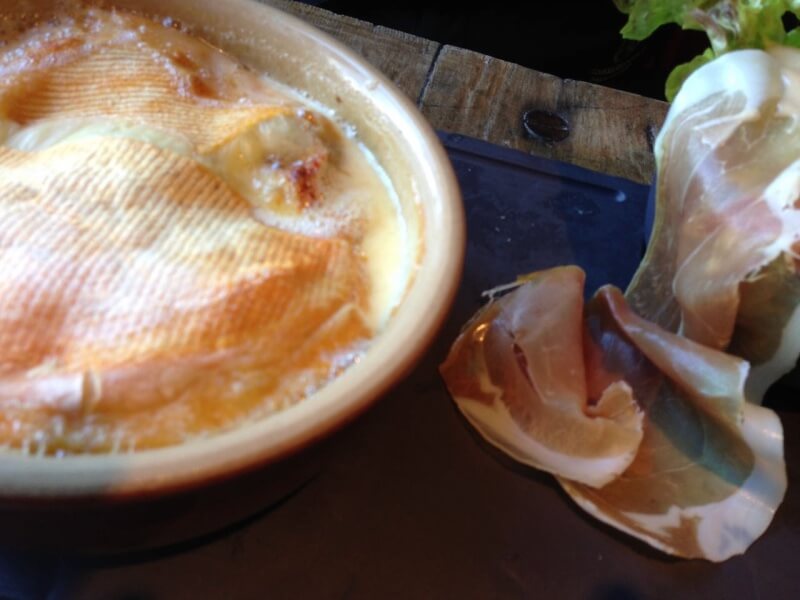 The tartiflette is a much-loved dish in the Alpine regions BUT it isn't traditional! It was invented in the 20th century to cater to tourist tastes for cheese and potato dishes
The tartiflette is a much-loved dish in the Alpine regions BUT it isn't traditional! It was invented in the 20th century to cater to tourist tastes for cheese and potato dishesBourgogne-Franche-Comté
This is a question that is asked of me often! We don't ALL eat snails (just like not all Brits eat Marmite or Americans hamburgers) but yes, it is a staple food and one which some of us (not all) learn to eat as children. Granted, the snails themselves don't have much taste, but the butter, garlic and bread make the supporting protein irrelevant.
Of course you've heard of Boeuf Bourguignon, which basically means beef from Burgundy (the region's English name). And Burgundy wine, which locals insist is far superior to Bordeaux, an argument that is known to have led to fisticuff throughout history.
Here are a few typical specialties from this region, which I also happen to know well because it is right next door to mine.
- Dijon mustard
- Tender Charolais beef, used in the best French meat dishes
- Morteau and Montbéliard sausages
- Cheeses, including two of my faves, Morbier and Mont d'Or (and one you won't believe!)
- Burgundy white and red wine, of course
- Gingerbread
- and yes, SNAILS. Escargots de Bourgogne. A classic French dish.
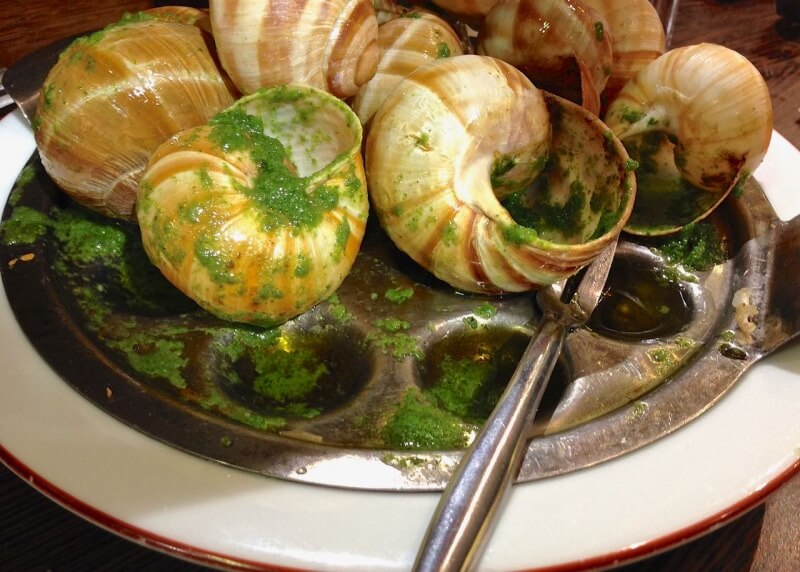 These escargots (yes, snails) are much maligned and far more delicious than you could possibly imagine - but you must love butter and garlic
These escargots (yes, snails) are much maligned and far more delicious than you could possibly imagine - but you must love butter and garlicBretagne (Brittany)
Bretagne, or Brittany, is a region of picturesque villages, wild beaches, and... megaliths. That's right. known for its coastal beauty and its rich food - and more than 3000 standing stones, like menhirs and dolmens dating from pre-Christian times.
As for culinary standouts, you'll probably be familiar with a few of these.
- La crêpe, a sweet thin pancake slathered with anything sweet, is one of the most famous French dishes
- The galette, its savory counterpart, beloved with ham and cheese and egg, and made with buckwheat, a traditional crop here
- Seafood, especially lobster, crayfish and mussels
- Salted caramel
- Artichokes and cauliflower from Brittany are sought after across France
- Kouign-amann (impossible to spell or pronounce), a rich flaky pastry so luscious your arteries will feel under attack
- Seafood!
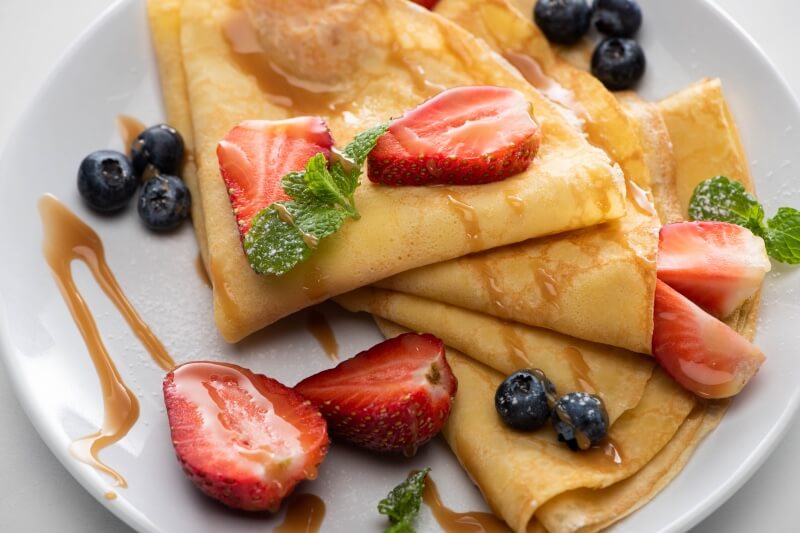 There is virtually no limit to what you can stuff a crêpe with - fruits, honey, sugar, lemon, even Nutella (a bit less traditional...) Its savory counterpart, the galette, is stuffed with anything from eggs to ham and cheese or vegetables. It is customary in a crêperie to eat a galette first, followed by a crêpe, all washed down with a glass of cider
There is virtually no limit to what you can stuff a crêpe with - fruits, honey, sugar, lemon, even Nutella (a bit less traditional...) Its savory counterpart, the galette, is stuffed with anything from eggs to ham and cheese or vegetables. It is customary in a crêperie to eat a galette first, followed by a crêpe, all washed down with a glass of ciderCentre-Val de Loire
This is the heartland of France, so popular with royalty in the Middle Ages and Renaissance that it is dotted with many extraordinary chateaux. The region also hosts the superb cathedral at Chartres. One of its great claims to fame, perhaps, is its proximity to Paris - all that history (and good Touraine, Vouvray and Sancerre wines) just an hour's train ride away...
Food, of course, is stellar (where is it not in France?) and some regional exports include:
- Tarte Tatin, a caramelized upside-down apple tart you eat warm with a dollop of vanilla ice cream or with custard
- Pet de nonne, which translates into 'nun's fart', a sweet puff pastry possibly named after a Sister Agnes, who might or might not have dropped a spoonful of batter into hot oil at the moment of a certain unexpected sound's release
- Creamy goat's cheese
- Candy! Made with barley sugar - sweets of different types, in fact; this part of France has a definite sweet tooth
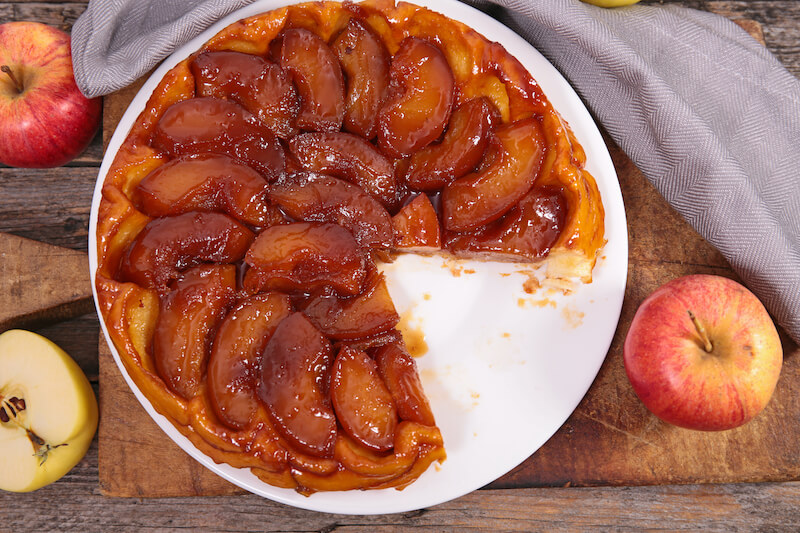 This is an addictive dessert, often found on menus across France. It is best eaten warm, with a dollop of ice cream, and sometimes ordered at the start of a meal (to give chefs time to get it ready for dessert!)
This is an addictive dessert, often found on menus across France. It is best eaten warm, with a dollop of ice cream, and sometimes ordered at the start of a meal (to give chefs time to get it ready for dessert!)Corsica
Corsica may be part of France, but it is best known as the birthplace of Napoleon Bonaparte (or Napoleone Buonaparte, as he was known at birth). Intriguingly, many of its specialties have an Italian flavor, as befits an island halfway between the two countries.
If there's one product that exemplifies Corsica, surely it is the chestnut, which is milled and used as flour for bread (in centuries past, the chestnut was even used as currency). Superstitions still surround the use of chestnuts for healing, and it continues to be popular in everything from soup to cakes to jam. Speaking of which, jams and all sorts of cold cuts are typical of Corsican fare.
- Brocciu, Corsica's "national" cheese
- Figatellu, a dry pork sausage
- Prisuttu, a local prosciutto
- Myrtle liqueur, called Mirto
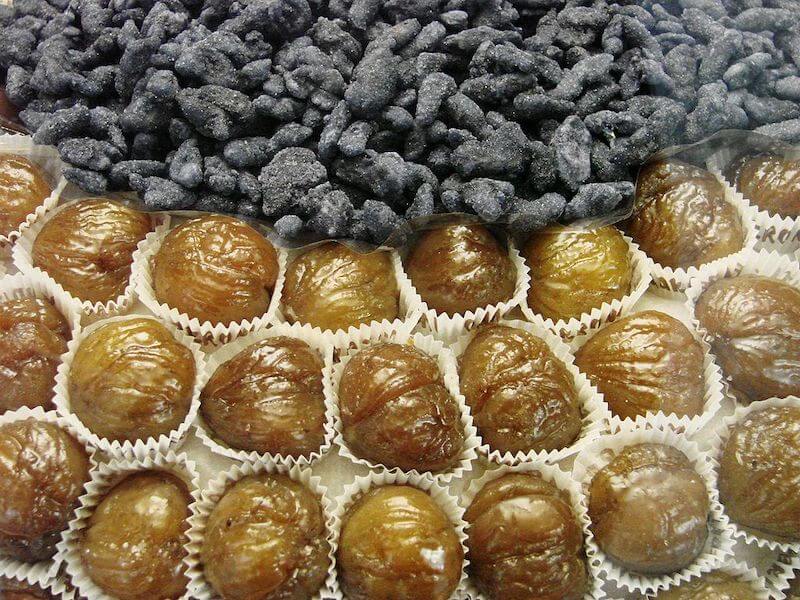 These golden globes will just melt in your mouth, one example of the multiple uses of the delightful chestnut "passamanerie" flaviab / CC BY-SA
These golden globes will just melt in your mouth, one example of the multiple uses of the delightful chestnut "passamanerie" flaviab / CC BY-SAGrand-Est
This richly traditional region is an administrative construction that contains three well-known former regions - the Alsace, the Lorraine, and the Champagne. It is a land of historical battlegrounds, feudal castles, sweet white wines and seat (shared with Brussels) of the European Parliament.
Proximity to Germany and Switzerland has influenced its foods, and the region is home to many specialties renowned not only across France but worldwide. This is a region that loves its food... mind you, I can't think of a region that doesn't. People here particularly love:
- Did I mention Champagne? And Alsatian wines?
- Choucroute, or saukerkraut, the perfect winter dish, garnished with port, a traditional French dish from Alsace
- The kougloff, which is also typical of Germany and Austria, a round molded brioche cake
- Pork products − ham, sausages, offal, anything pork
- Quiche Lorraine, of course, which is surely one of the top 10 French foods
- Chaource cheese, made from raw cow's milk
- The Alsatian Flammekueche, a pizza-like crust baked on an open fire and slathered in bacon, cream and onions
- Very smelly cheeses...
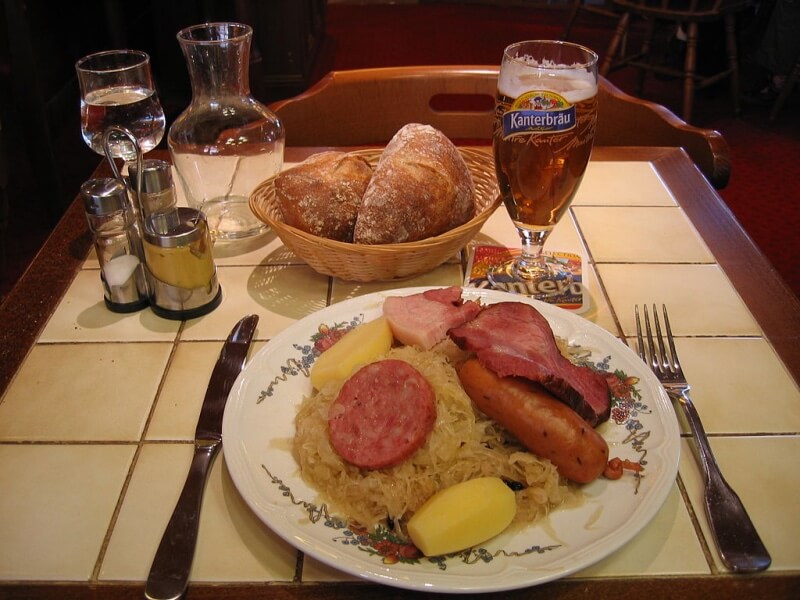 A typical choucroute (sauerkraut), a favorite winter dish that sticks to your ribs
A typical choucroute (sauerkraut), a favorite winter dish that sticks to your ribs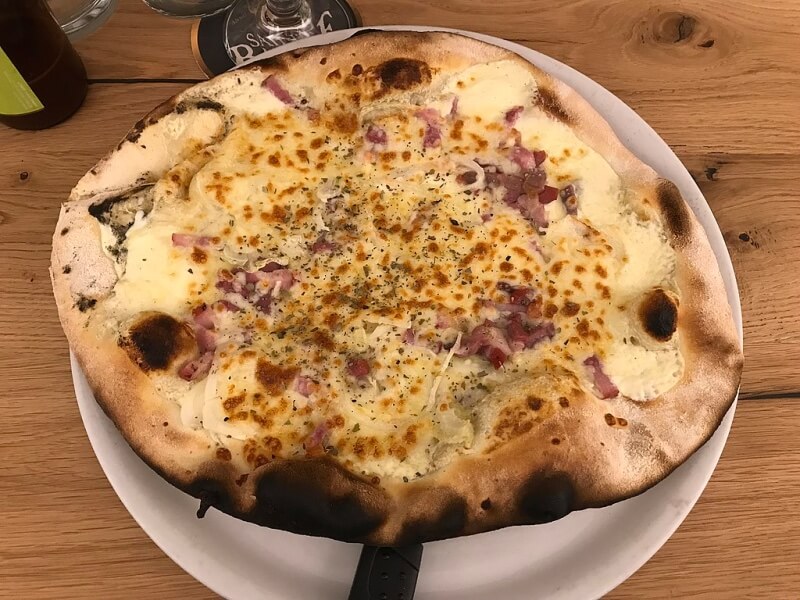 A rich, delightful flammekueche! (Benoît Prieur, CC0, via Wikimedia Commons)
A rich, delightful flammekueche! (Benoît Prieur, CC0, via Wikimedia Commons)Hauts-de-France
This is a flat region whose plains bleed seamlessly into Belgium and what comes to mind here are its numerous World War I and II battlefields: Vimy Ridge, the Somme, Dunkirk...
This may be an industrial area, but it is also strong on agriculture and while it has plenty of tourist attractions (especially religious architecture), it is a bit off the beaten path so you'll have it all yourself (more or less). This is a foodie region, although you may mistakenly think you've wandered across the border - the foods are that similar.
- Beer
- Carbonnade flamande (remember, Flamande means Flemish, as in... Belgium!), beef stewed with beer and onions
- French Fries - les frites! (possibly the most popular food in France)
- And then there's moules-frites, mussels with french fries
- Did I mention beer? Everything in this region seems to be cooked in beer, as opposed to other French regions, where everything is cooked in wine or cream...
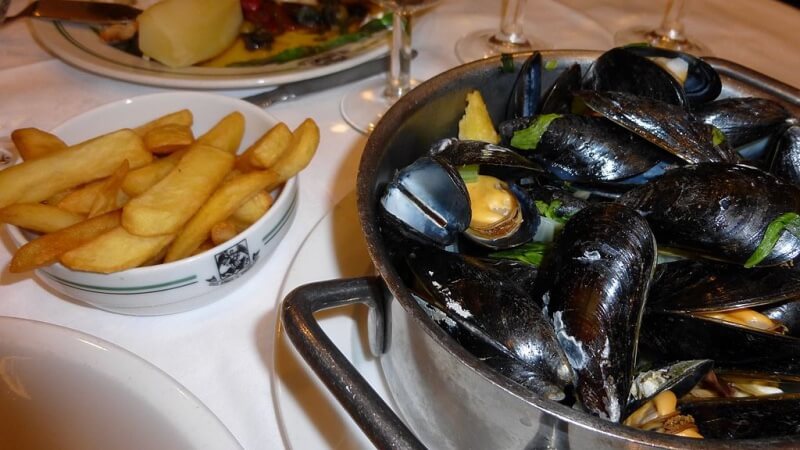 A classic of northern France, especially near the Belgian border: moules-frites, or mussels with fries... to be eaten with fingers Bloguer / CC BY-SA
A classic of northern France, especially near the Belgian border: moules-frites, or mussels with fries... to be eaten with fingers Bloguer / CC BY-SAÎle-de-France
This region requires no description: simply put, this is Paris. But just because it's the most romantic capital in the world, with incredible shops and stunning art and architecture, doesn't mean it doesn't have its own culinary specialties...
- Paris shines with its pastries... including my favorite, the Opéra, but also the Paris-Brest, St Honoré and macarons!
- The champignon de Paris, a fat white mushroom you'll find everywhere
- Brie cheese...
- Onion soup au gratin, a late-night favorite and one of the famous dishes in France
- Bistrot food, the sophisticated equivalent of fast food, such as the croque-monsieur
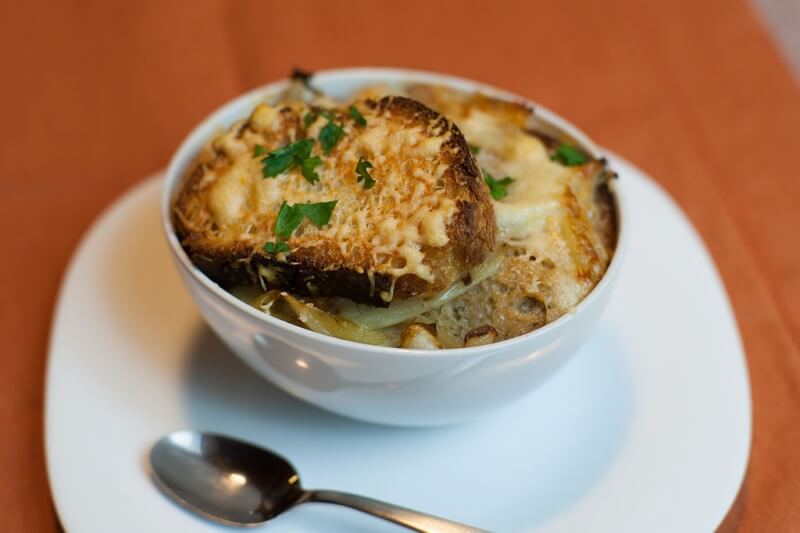 Here's a French dish that has traveled well beyond our borders! A crusty French onion soup savored on a cold winter day...
Here's a French dish that has traveled well beyond our borders! A crusty French onion soup savored on a cold winter day...Normandie
Normandy is a visual paradise, with its attractive beaches and pretty harbor villages, its rolling fields filled with Normandy cattle, D-Day beaches, Deauville – and home to the tapestries of Bayeux. But say Normandie to a French person and we'll immediately start dreaming of apples (cider) and butter and cream.
- Tripe. It's an acquired taste (one I haven't acquired yet)
- Cider and Calvados, both much loved throughout the country
- Camembert, right? It comes from the village of Camembert in the Calvados. The familiar round, wooden box is a staple on French tables
- Oysters, mussels, scallops (for this alone I'll spend 6 hours on the train!) and sole
- Caramels from Issigny, which take advantage of the delicious cream and butter you'll find here
- And what we call the trou normand, or Normandy pause... It's basically a palate cleanser, usually apple sherbet with a glass of Calvados in-between courses, particularly if you are having a very large meal
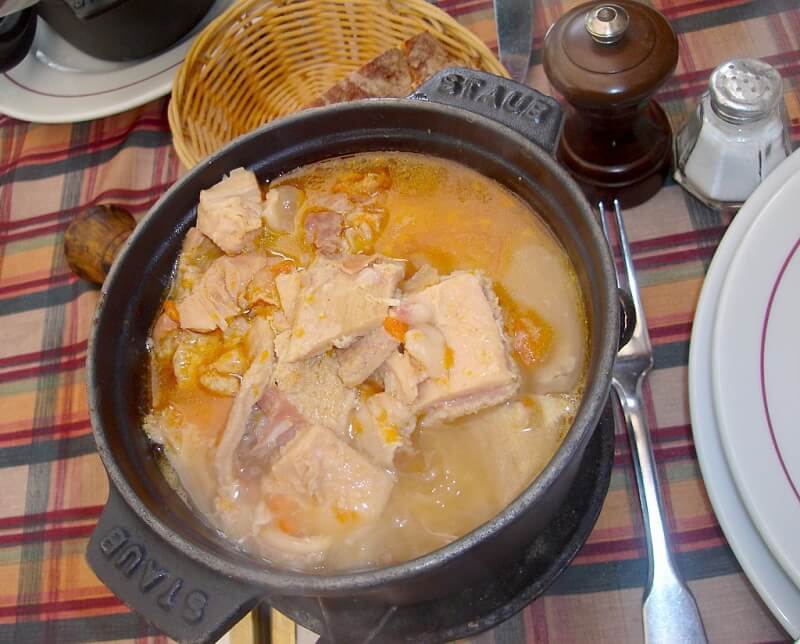 This tripe dish, known as 'à la mode de Caen', is loved by... those who love it, but definitely an acquired taste. Yun Huang Yong / CC BY-SA
This tripe dish, known as 'à la mode de Caen', is loved by... those who love it, but definitely an acquired taste. Yun Huang Yong / CC BY-SANouvelle-Aquitaine
This is largely a coastal region and much of it is somehow linked to water, whether the seafood or the pleasant climate or the seaside resorts and attractions. This is the home of Bordeaux, deemed one of the world's best cities to visit, and Biarritz, one of France's least snobbish upper class resorts. There's also a distinctive Spanish influence – you're never very far from the border.
It is of course home to exquisite food: it is, after all, the French portion of the Basque country, and we know just how many chefs the Basques have exported across France and to the rest of the world.
I gained three pounds in Aquitaine, where I visited for a week. Nuff said. Now, about those culinary gems...
- Bordeaux wine, bien sûr
- Foie gras (yes, there is plenty of controversy around this)
- Duck products − all meat products, in fact, with excellent beef, lamb and pork
- Oysters from the Charente-Maritime and Arcachon Basin
- Truffles and plenty of other mushrooms
- Prunes from Agen
- Canelés from Bordeaux, those little ridged custard mounds with hints of vanilla and rum
- Caviar (in the Dordogne)
- Basque cuisine and its use of Espelette chillies
- Cognac, of course, from the town of Cognac
- Armagnac eau de vie
Occitanie
The Occitanie has beaches, the Pyrenee Mountains, but what strikes me most is the region's historical legacy: Carcassonne, the Cathar castles, Roman ruins and Gothic palaces, stunning villages and fortified towns. Whatever your preferred historical period, you'll find it covered here.
So it should be no surprise that Occitanie is also a hotbed of foodie traditions...
- Roquefort, bien sûr, the "king of cheeses", produced in the underground galleries of Roquefort-sur-Soulzon
- Cassoulet, a traditional French dish: a white bean and pork casserole dating back to the Middle Ages; French food recipes often vary from town to town but cassoulet usually includes goose or duck confit, white beans, pork, sausage, onions and carrots
- Foie gras (yes, here too)
- Saucisse (sausage) de Toulouse
- Light white wines, like Chasselas and Muscat
- Black ham of Bigorre
- Camargue rice (often termed wild rice)
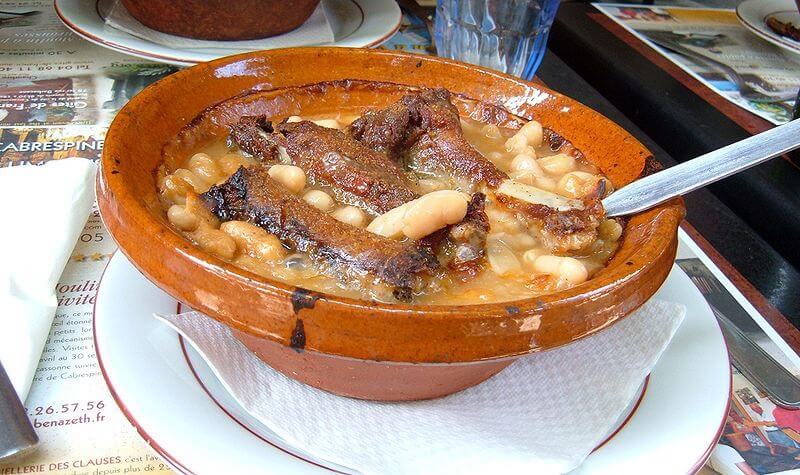 France does love its stews... often, they're from the north, where the weather is colder but now, but the Cassoulet is typical of the south and the Pyrenees (which, granted, are colder than the plain below) BrokenSphere / CC BY-SA
France does love its stews... often, they're from the north, where the weather is colder but now, but the Cassoulet is typical of the south and the Pyrenees (which, granted, are colder than the plain below) BrokenSphere / CC BY-SAPays de la Loire
Don't confuse the Pays de la Loire with the Centre-Val de Loire, although the person who chose these names should be punished with a silly name of their own. So yes, they are both part of the Loire Valley, and they happen to be next to one another.
The Pays de la Loire roughly covers the western part of what should logically be called the Loire region, while the Centre-Val de Loire covers the east. Did I mention the French were a complex bunch? In this case, I should say confused, not complex. The tip of this region abuts Brittany, and they often share a common history. For example, the city of Nantes is in the Pays de la Loire but historically, it belongs to Brittany... go figure. That controversy is ongoing. French logic.
So yes, plenty of chateaux here too, along with history galore, and agriculture, which leads to...
- Asparagus
- Beurre blanc (white butter), a butter sauce made with white wine and shallots
- Sel de Guérande, a pure hand-harvested salt (which was originally from Brittany until regional boundaries were redrawn and the village and salt flats landed in the Pays de la Loire region)
- All kinds of river fish
- Rillettes (a chunky pork paté) du Mans
- Goat cheeses (this region produces half of France's stock)
- The sablé, a dry little buttery biscuit or pie dough
- Cointreau and Triple Sec orange liqueurs
- Cabernet d'Anjou rosé wine
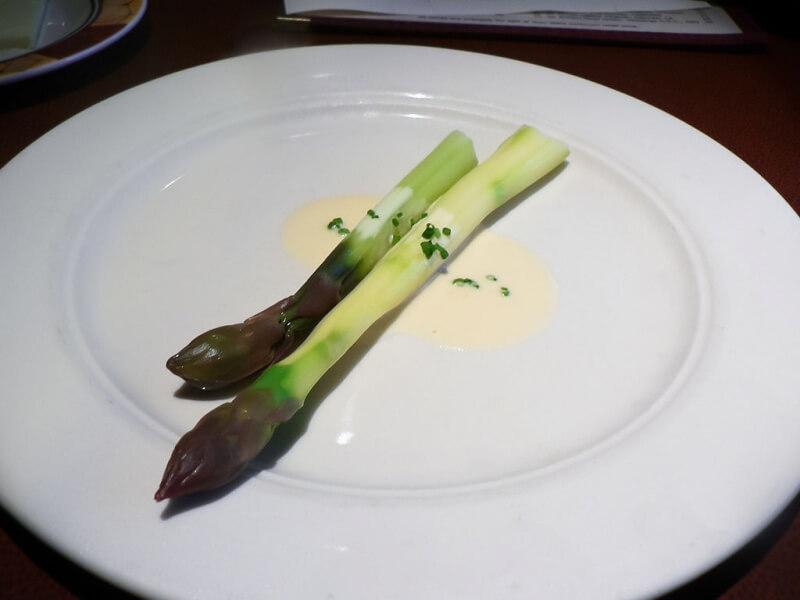 Asparagus with 'beurre blanc', white butter stu_spivack / CC BY-SA
Asparagus with 'beurre blanc', white butter stu_spivack / CC BY-SAProvence-Alpes-Côte d'Azur
This is an emblematic region of France and, along with Paris, the most visited in France. There is little need to introduce this admirable region that stretches from the Camargue to the Italian border, covering the French Riviera – which we call the Côte d'Azur – as well as the Southern Alps and all the impossibly charming villages of the interior.
This combination of mountains, foothills and sea, along with proximity to Italy, guarantee a diverse palate with a hefty influence of sunshine. Here are some of my favorite specialties:
- Notable prepared dishes from the French Riviera such as tapenade (olive garlic purée), pistou soup or Niçoise salad (vegetables plus anchovies, tuna and hard-boiled egg)
- Bouillabaisse (fish stew) from Marseille
- The tian is a sort of vegetable flan
- Calissons d’Aix, a sweet marzipan covered with crackling icing and shaped like a diamond
- Les herbes de Provence, a mixture of herbs used in cooking
- Wild rice and salt from the Camargue
- Pastis, the aniseed-flavoured French aperitif
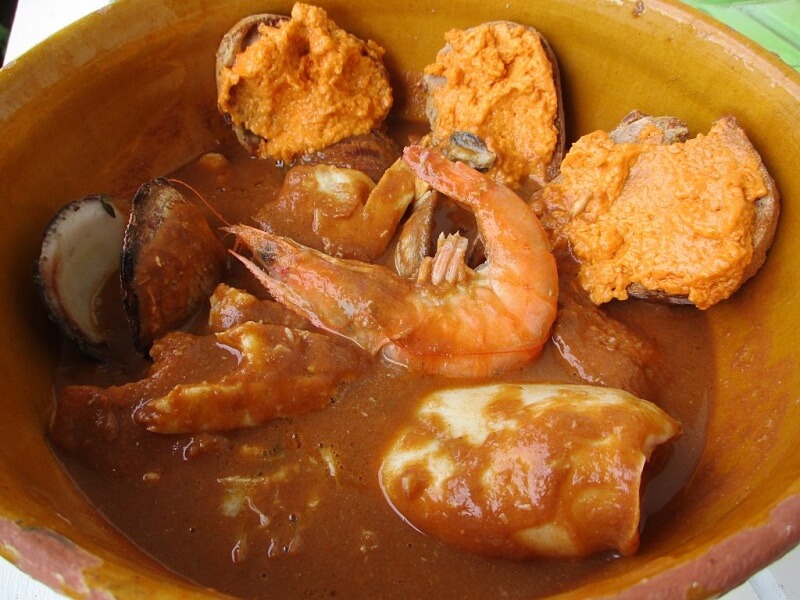 The classic bouillabaisse, to be savored along the Mediterranean coast while watching the boats come into port. Arnaud 25 / CC BY-SA
The classic bouillabaisse, to be savored along the Mediterranean coast while watching the boats come into port. Arnaud 25 / CC BY-SA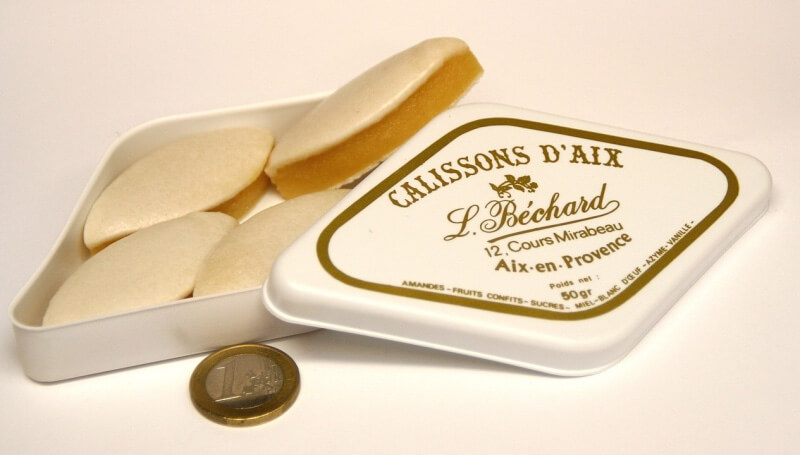 It's fitting to end with these Calissons d'Aix, sweet coated marzipan (you can't just have one). Mathsci English Wikipedia via CC BY-SA 3.0
It's fitting to end with these Calissons d'Aix, sweet coated marzipan (you can't just have one). Mathsci English Wikipedia via CC BY-SA 3.0The groups that represent them
France's food is serious business, so serious we do everything we can to protect and promote our products. Walk into any French representation overseas and you'll soon see posters or brochures extolling our foods and wine. It's a topic that never tires us.
One particularity of France is its associative nature: there's an association for everything, from protecting a riverbed to promoting a cause. So it is not surprising to find associations that represent what we call the 'metiers de la bouche' or the professions of the mouth.
Take the MOF, for example, the Meilleurs Ouvriers de France, or Best Workers of France (somehow the English doesn't sound half as dignified). This elite association is joined by passing incredibly difficult exams, and the successful outcome of these exams can make or break a career, especially in the culinary arts (although the MOF exists for many trades, from plumbing to ironwork). There's even a museum in the MOFs' honor (the site is in French).
But belonging to the MOF is not the only path to culinary greatness, and there are plenty of extraordinary non-MOF food specialists who sit on juries and are world-renowned: not every culinary artiste chooses to be subjected to the grueling MOF process because, like the Michelin stars, not everyone wants one; it may come with recognition, but also with heavy responsibilities.
Another group that represents France's culinary output are the country's product-based brotherhoods, the confréries, whose job it is to promote a specific product.
For example, the Chevaliers de l'Olivier de Nyons, the Brotherhood of the Knights of the Nyons Olive Tree, spends its summer season touring Provence to promote this most excellent of olives... You'll find similar brotherhoods for everything from garlic to wines. They are a joy to watch – colorful processions combined with local festivities and tastings. Many famous French foods may well owe their survival or renewed popularity to promotion by one of these traditional brotherhoods.
Did you enjoy this article? I'd love if you shared it!
